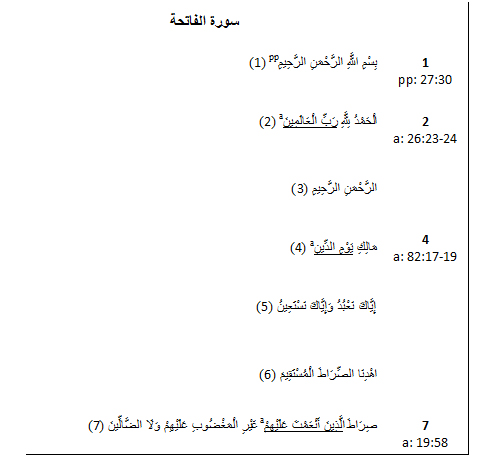Growing Pains of Qur’anic Studies
by Devin Stewart*
 On the one hand, the explosion of interest in the Qur’an over the past several decades is a blessing, as it has produced a sharp rise in the rate at which scholarship in Qur’anic studies is being produced, as well as in the number of different approaches. Entire fields of inquiry that had been moribund for the latter half of the twentieth century have now come alive, including study of the manuscript traditions of the Qur’an and the relationship between the Qur’an and Jewish and Christian texts. On the other hand, such burgeoning interest means that, as with Biblical scholarship, the number of people writing on the topic is large, the number of studies is huge, and one must wade through a morass of published material presenting rehashed versions of old theses in order to find significant advances.
On the one hand, the explosion of interest in the Qur’an over the past several decades is a blessing, as it has produced a sharp rise in the rate at which scholarship in Qur’anic studies is being produced, as well as in the number of different approaches. Entire fields of inquiry that had been moribund for the latter half of the twentieth century have now come alive, including study of the manuscript traditions of the Qur’an and the relationship between the Qur’an and Jewish and Christian texts. On the other hand, such burgeoning interest means that, as with Biblical scholarship, the number of people writing on the topic is large, the number of studies is huge, and one must wade through a morass of published material presenting rehashed versions of old theses in order to find significant advances.
There is nothing wrong with a professor of creative writing, like Reza Aslan—or even the local motel night-clerk for that matter—publishing on the Qur’an, as long as the individual in question has something worth saying. To cast doubt on the person’s right to do so is indeed to make an ad hominem argument, and if one wanted to waste time, one could trump up a case and characterize Aaron Hughes as an expert in Jewish philosophy who is less than ideally qualified to issue judgments about the Qur’an or early Islamic history. Indeed, there are few doctoral programs in Qur’anic studies per se, so we could probably whittle down the category of professional scholars of Qur’anic studies to nearly nil. But, as a medieval Arabic adage has it, lā taʿrif al-ḥaqq bi’l-rijāl fa-taqaʿ fī mahāwī al-ḍalāl (“Do not know truth by the man, lest you fall into the abyss of error”). The issue is not whether the proponent of an idea is an amateur or a professional. Amateurs are capable of producing important results as long as they do their homework; conversely, professionals are capable of error if they don’t do theirs. The proof is in the pudding. After all, Michael Ventris, the architect who deciphered Linear B—to my mind one of the most brilliant achievements in the humanities in the twentieth century—was by all accounts an amateur. The problem with Aslan’s posts on this blog is that they do not present anything new and interesting about the Qur’an, and so fall into that benign but unfortunate category of scholarship-lite™, which, as the Qur’an becomes increasingly popular, will not go away anytime soon. The appropriate response is probably silence, or perhaps a disgruntled yawn in the privacy of one’s living room.
IQSA might serve to raise the average quality of publications on the Qur’an by continuing to do what it has set out to do: holding conferences, publishing a journal, fostering global scholarly exchange, and so on. By guiding interested parties to what has been done in scholarship to date, we may avoid reinventing the wheel, which in my view is a major problem in Qur’anic studies, because many writers on the Qur’an have only limited knowledge of Arabic and maybe one or two other languages and so do not take adequate account of what has been done in medieval and modern scholarship in many different languages—especially modern German scholarship. The publication of the Encyclopaedia of the Qur’an (not to mention its translation into Persian, currently in progress) was a major step in remedying this situation, as were the publications of English and Arabic translations of Goldziher’s Die Richtungen der islamischen Koranauslegung and Nöldeke’s Geschichte des Korans, but additional guidance would be useful in the form of bibliographical guides (such as Karimi-Nia’s Bibliography of Qur’anic Studies in European Languages) for neophytes of all stripes.
One quick way for investigators to orient themselves to existing scholarship before proposing what they think is a novel interpretation of a Qur’anic passage is to look at Rudi Paret’s Der Koran: Kommentar und Konkordanz, which gives parallel verses for passages in question and also brief reports on much of the previous scholarship on the passage. Like Brockelmann’s Geschichte der Arabischen Litteratur, Paret’s book may be used to some effect even by those without a profound knowledge of German, although some familiarity with German certainly helps. I have often found that our Qur’an seminar sessions benefit from an initial look at Paret to avoid reinventing the wheel.
* Devin Stewart is Associate Professor of Arabic and Middle Eastern studies at Emory University.
© International Qur’anic Studies Association, 2015. All rights reserved.




